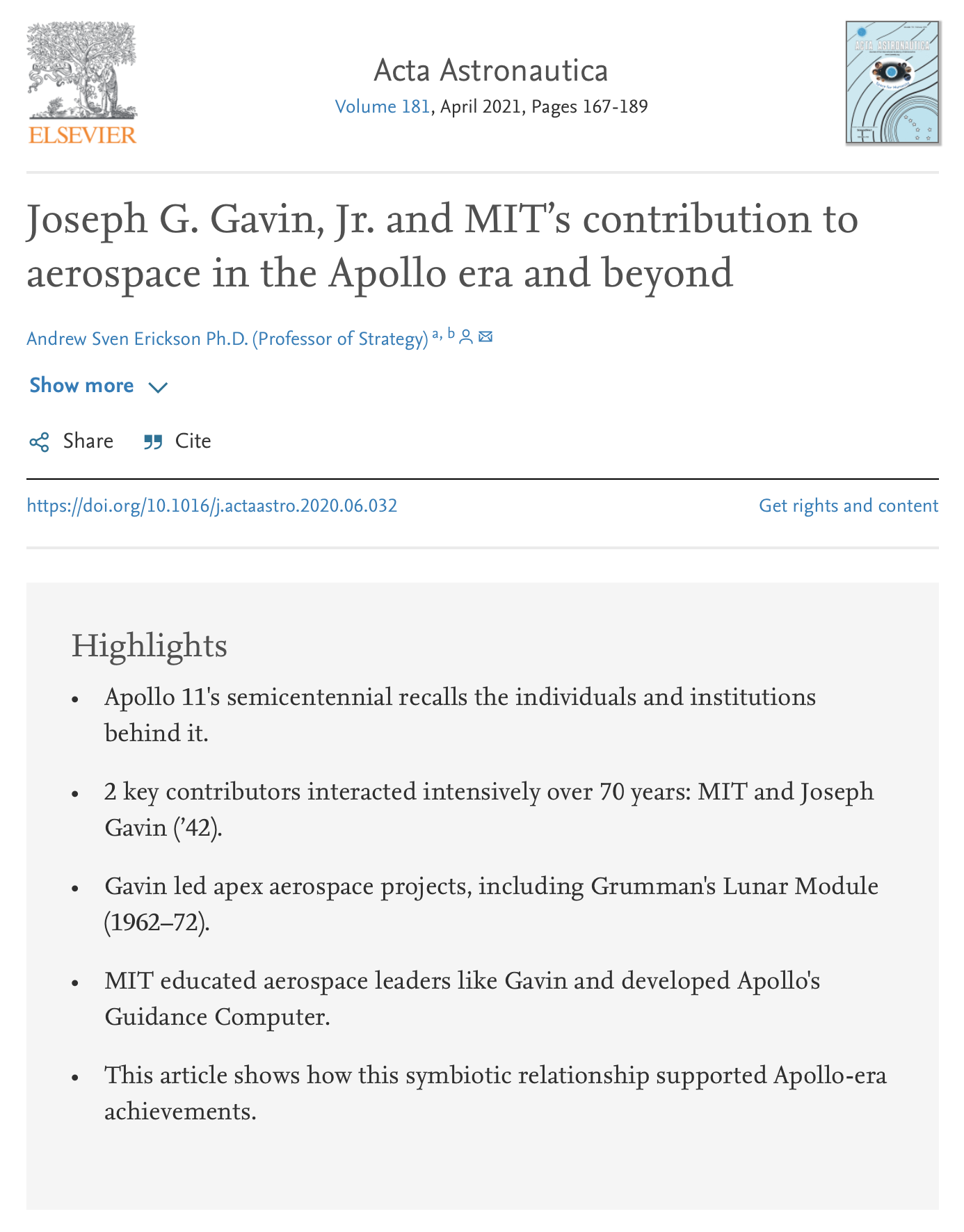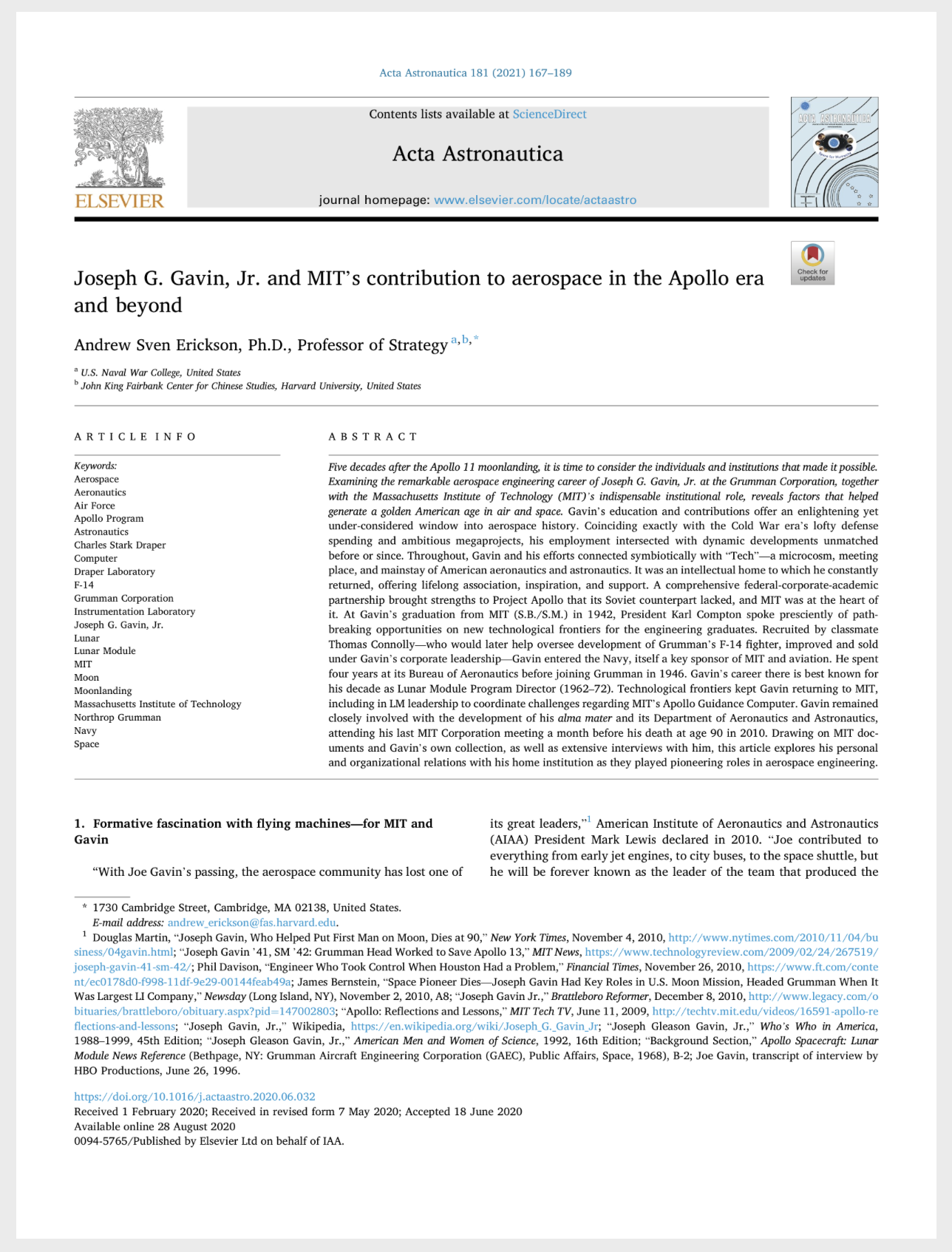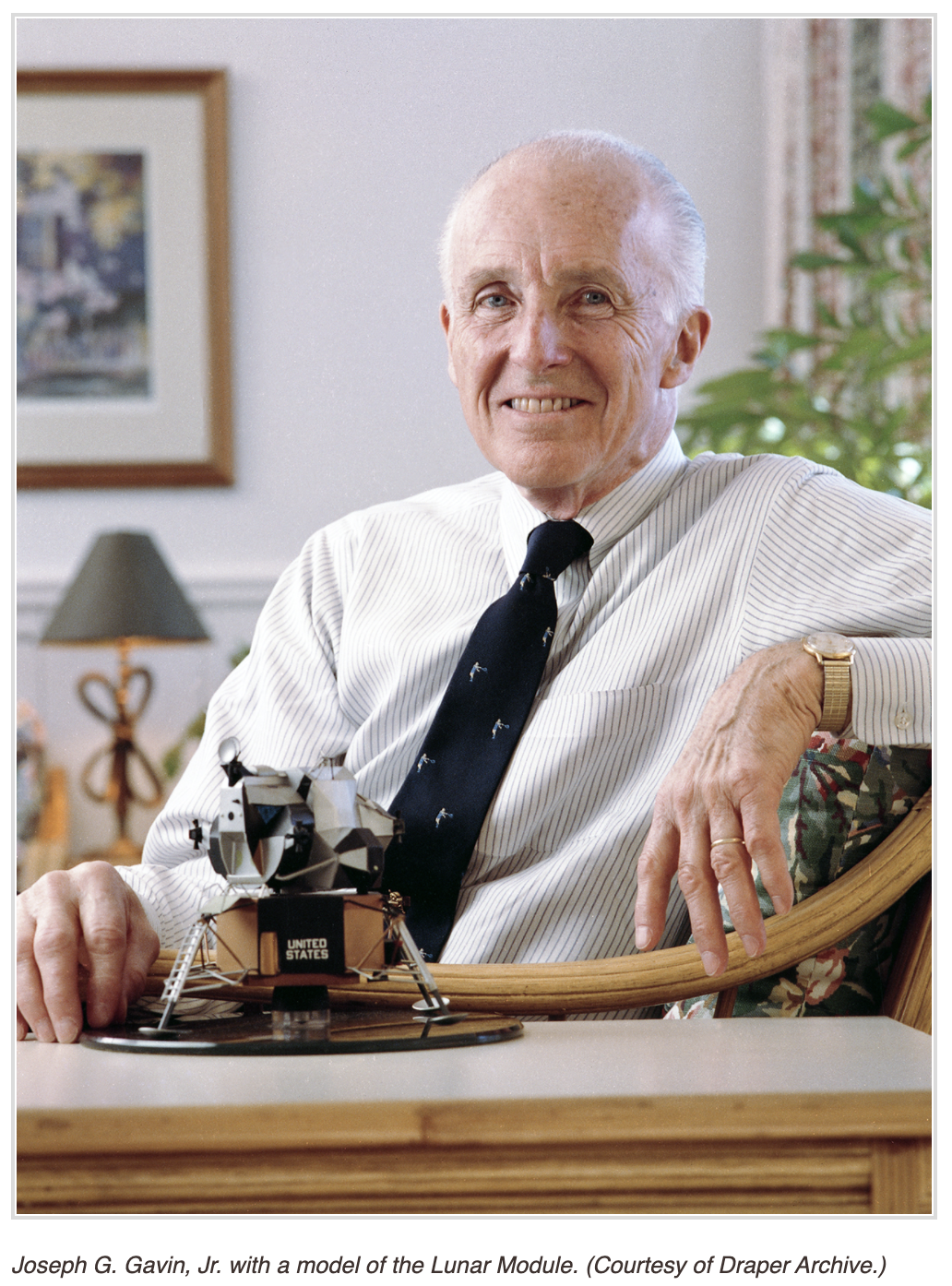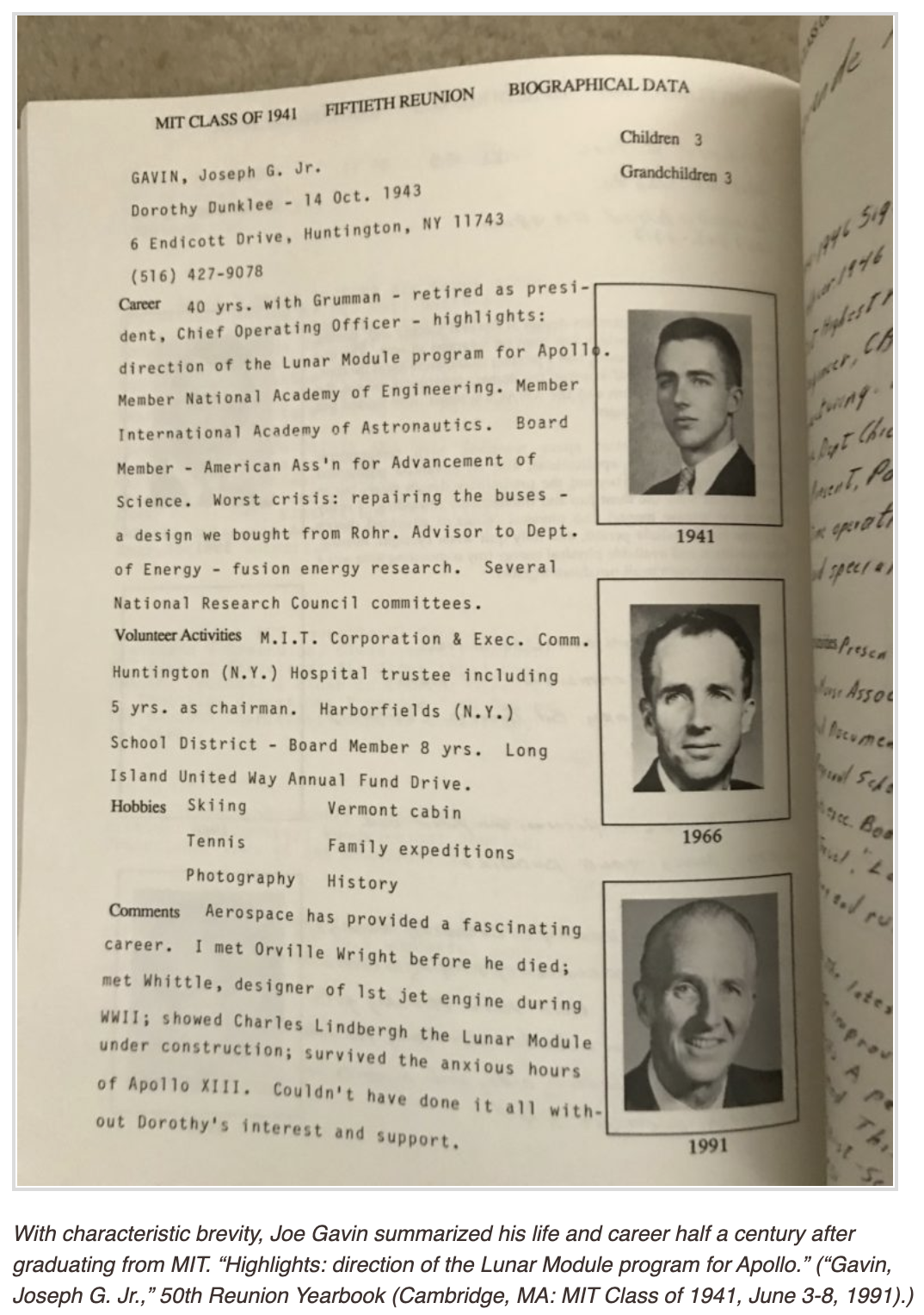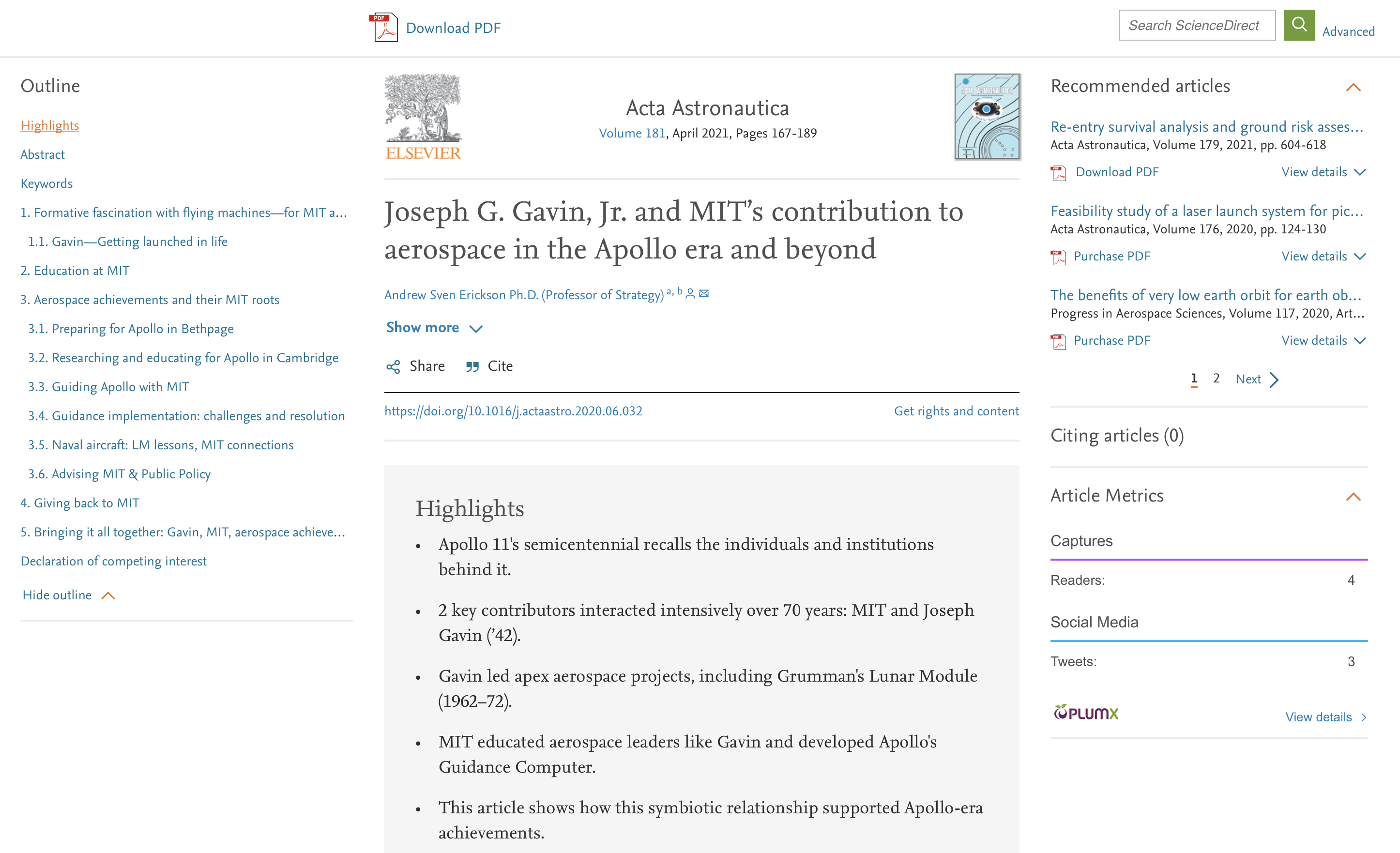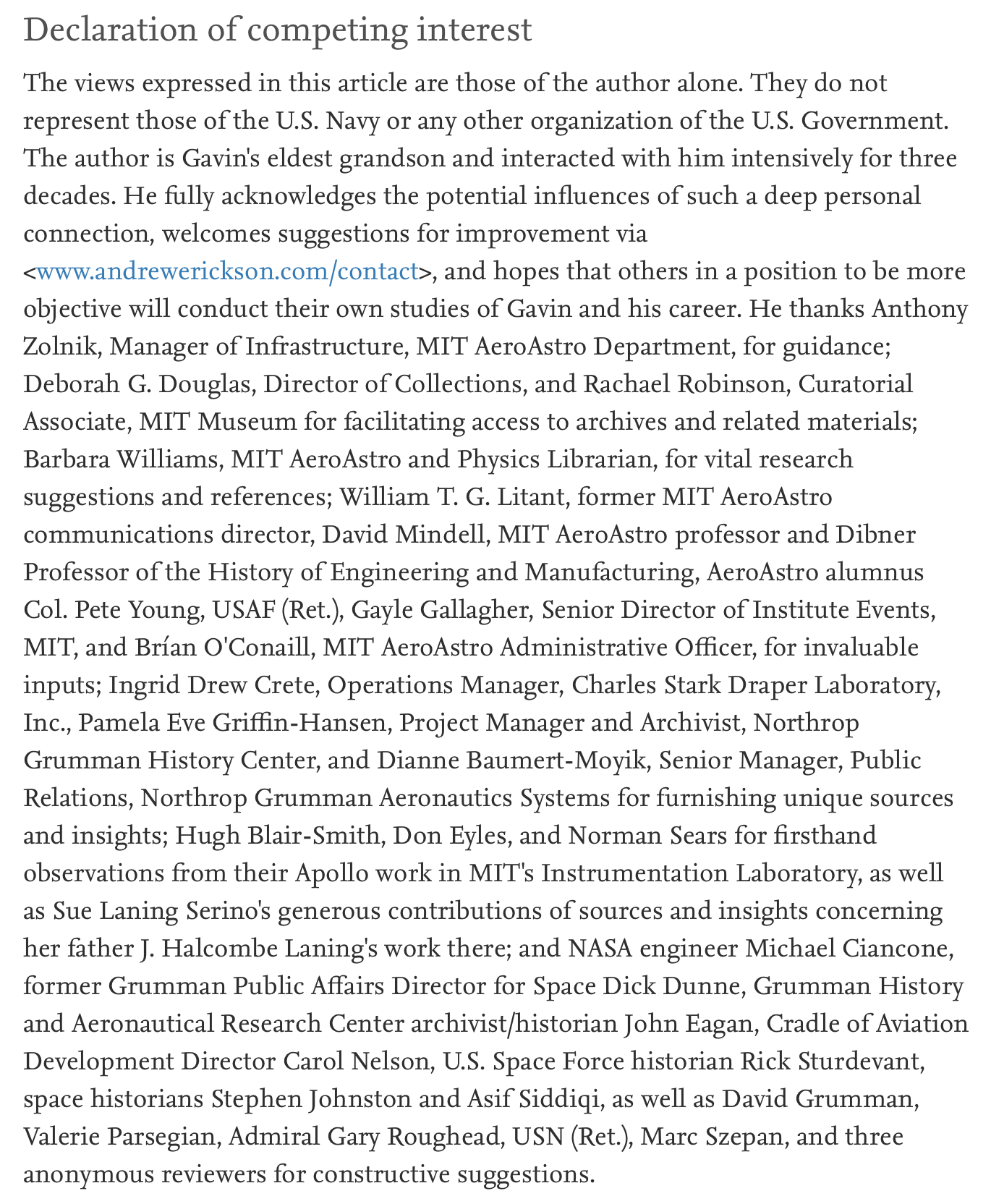Joseph G. Gavin, Jr. and MIT’s Contribution to Aerospace in the Apollo Era and Beyond
Andrew Sven Erickson Ph.D. (Professor of Strategy)ab, “Joseph G. Gavin, Jr. and MIT’s Contribution to Aerospace in the Apollo Era and Beyond,” Acta Astronautica, Volume 181 (April 2021): 167–89.
Highlights
- Apollo 11’s semicentennial recalls the individuals and institutions behind it.
- 2 key contributors interacted intensively over 70 years: MIT and Joseph Gavin (’42).
- Gavin led apex aerospace projects, including Grumman’s Lunar Module (1962–72).
- MIT educated aerospace leaders like Gavin and developed Apollo’s Guidance Computer.
- This article shows how this symbiotic relationship supported Apollo-era achievements.
Abstract
Five decades after the Apollo 11 moonlanding, it is time to consider the individuals and institutions that made it possible. Examining the remarkable aerospace engineering career of Joseph G. Gavin, Jr. at the Grumman Corporation, together with the Massachusetts Institute of Technology (MIT)’s indispensable institutional role, reveals factors that helped generate a golden American age in air and space. Gavin’s education and contributions offer an enlightening yet under-considered window into aerospace history. Coinciding exactly with the Cold War era’s lofty defense spending and ambitious megaprojects, his employment intersected with dynamic developments unmatched before or since. Throughout, Gavin and his efforts connected symbiotically with “Tech”—a microcosm, meeting place, and mainstay of American aeronautics and astronautics. It was an intellectual home to which he constantly returned, offering lifelong association, inspiration, and support. A comprehensive federal-corporate-academic partnership brought strengths to Project Apollo that its Soviet counterpart lacked, and MIT was at the heart of it. At Gavin’s graduation from MIT (S.B./S.M.) in 1942, President Karl Compton spoke presciently of pathbreaking opportunities on new technological frontiers for the engineering graduates. Recruited by classmate Thomas Connolly—who would later help oversee development of Grumman’s F-14 fighter, improved and sold under Gavin’s corporate leadership—Gavin entered the Navy, itself a key sponsor of MIT and aviation. He spent four years at its Bureau of Aeronautics before joining Grumman in 1946. Gavin’s career there is best known for his decade as Lunar Module Program Director (1962–72). Technological frontiers kept Gavin returning to MIT, including in LM leadership to coordinate challenges regarding MIT’s Apollo Guidance Computer. Gavin remained closely involved with the development of his alma mater and its Department of Aeronautics and Astronautics, attending his last MIT Corporation meeting a month before his death at age 90 in 2010. Drawing on MIT documents and Gavin’s own collection, as well as extensive interviews with him, this article explores his personal and organizational relations with his home institution as they played pioneering roles in aerospace engineering.
Keywords
Outline
- Highlights
- Abstract
- Keywords
- 1. Formative fascination with flying machines—for MIT and Gavin
- 2. Education at MIT
- 3. Aerospace achievements and their MIT roots
- 4. Giving back to MIT
- 5. Bringing it all together: Gavin, MIT, aerospace achievements
- Declaration of competing interest
1. Formative fascination with flying machines—for MIT and Gavin
“With Joe Gavin’s passing, the aerospace community has lost one of its great leaders,”1 American Institute of Aeronautics and Astronautics (AIAA) President Mark Lewis declared in 2010. “Joe contributed to everything from early jet engines, to city buses, to the space shuttle, but he will be forever known as the leader of the team that produced the Apollo Lunar Module, one of the greatest engineering accomplishments in human history.”2 Gavin helped develop Grumman’s most noteworthy systems throughout its heyday as an innovator primarily serving the U.S. government,3 particularly the military.4 Within Grumman, his career likewise tracked the most dynamic elements. In the first phase, he was directly involved in the development of naval aircraft, a core Grumman product. He would return to this focus in his third and final phase as a senior manager. At the beginning of the middle phase, as Grumman built a space business, he headed the development of several key aerospace products, including the Orbiting Astronomical Observatory (a precursor to the Hubble Space Telescope) as Grumman’s chief missile and space engineer.
It was the Apollo program that most captivated Gavin, and consumed the middle phase of his career. He believed it “would be the biggest engineering job of history … bigger than building the pyramids or inventing the airplane and would take every ounce of ingenuity … to pull off.”5 From 1962–72, Gavin oversaw as many as 7,500 employees as director of the Lunar Module (LM) program. NASA awarded him the Distinguished Public Service Medal for his role in saving the Apollo 13 mission; and in 1974 he became the latest of the many MIT affiliates elected to the National Academy of Engineering. “For the 1960s, that was the place to be, that was the program to be involved with,” he later reflected. “As tough as it was, none of us would have chosen not to be there.”6
Gavin’s wide range of responsibilities, contacts, and experiences—combined with a penchant for travel that included attendance at virtually every International Astronautical Congress (IAC) from 1980 to 2005—afforded him unusual insights into the geopolitics, military-technological frontier, and policies of his era. Aside from several characteristically succinct presentations, however, Gavin’s humility and persistent focus on the future dissuaded him from writing a memoir or otherwise publicizing his experiences.7 “Those who knew Joe knew he never sought to be in the limelight, though, as head of our space program, he should have been,” Northrop Grumman vice president Patricia McMahon stated upon Gavin’s death in 2010. “He was one of the great pioneers in the aerospace industry.”8
As a world-leading institution of technology research and education, Gavin’s alma mater MIT is naturally far better known than he. Yet their efforts were intertwined and integrated throughout the first aerospace age, and MIT’s unique role merits further recognition and understanding. Well represented on the frontiers of science and technology, the MIT community includes 50 Nobel laureates, 33 MacArthur fellows, and 160 members of the National Academy of Sciences. MIT has produced more astronauts than any other school. Globally, alumni have founded nearly 26,000 companies, wherein 3.3 million employees have generated two trillion dollars’ annual revenue—equivalent to the world’s eleventh-largest economy.9 To date, MIT’s Department of Aeronautics and Astronautics (AeroAstro) records, “Five MIT faculty have served as chief scientist for the Air Force. More than 25 percent of professors in the nation’s leading aerospace programs are MIT alumni. The aerospace program heads at a number of other world-class U.S. institutions are AeroAstro alumni.”10 These achievements unfolded over the course of Gavin’s career. “With a bigger faculty, more graduate students, closer ties to industry, and better representation on government advisory panels than any other institution, MIT set the pattern for postwar aeronautics,” historian Stuart Leslie elaborates. “Its graduates went on to become executives and chief engineers at leading aerospace contractors from Long Island to Los Angeles, highly placed officers in the Army, Navy, and Air Force (including two Secretaries of the Air Force),11 and top academics at MIT and other universities.”12 On the threshold of that golden era, Jerome Clarke Hunsaker, who pioneered both American aviation and MIT’s dominance within it, remarked that “MIT graduates include the chief engineers or engineering directors of Curtiss-Wright, Glenn L. Martin, Pratt & Whitney, Vought, Hamilton Standard, Lockheed, Stearman, and Douglas, as well as the engineer officers of the Naval Aircraft Factory and of Wright Field.”13 Accordingly, National Air and Space Museum senior curator Tom Crouch assessed nearly a century later, “AeroAstro at MIT has had a more extraordinary influence on our technology than almost any other institution.”14
To draw larger lessons from this unique confluence of capabilities, this article traces the interaction of Gavin and his Grumman team with MIT and NASA to find reliable solutions for successful missions. It explores the whole-of-nation development of technology from start to spaceflight and how the participants made adjustments based on information from experience. It thereby offers deeper understanding of the intimate connections between American industrial aerospace and academia that emerged during the second half of the 20th century, with particular insights into a major participant’s personal interface within a public-private partnership involving a government agency providing effective management, a private company furnishing reliable products, and an academic institution serving as a vital educator and enabler.15 … … …
Declaration of competing interest
The views expressed in this article are those of the author alone. They do not represent those of the U.S. Navy or any other organization of the U.S. Government. The author is Gavin’s eldest grandson and interacted with him intensively for three decades. He fully acknowledges the potential influences of such a deep personal connection, welcomes suggestions for improvement via <www.andrewerickson.com/contact>, and hopes that others in a position to be more objective will conduct their own studies of Gavin and his career. He thanks Anthony Zolnik, Manager of Infrastructure, MIT AeroAstro Department, for guidance; Deborah G. Douglas, Director of Collections, and Rachael Robinson, Curatorial Associate, MIT Museum for facilitating access to archives and related materials; Barbara Williams, MIT AeroAstro and Physics Librarian, for vital research suggestions and references; William T. G. Litant, former MIT AeroAstro communications director, David Mindell, MIT AeroAstro professor and Dibner Professor of the History of Engineering and Manufacturing, AeroAstro alumnus Col. Pete Young, USAF (Ret.), Gayle Gallagher, Senior Director of Institute Events, MIT, and Brían O’Conaill, MIT AeroAstro Administrative Officer, for invaluable inputs; Ingrid Drew Crete, Operations Manager, Charles Stark Draper Laboratory, Inc., Pamela Eve Griffin-Hansen, Project Manager and Archivist, Northrop Grumman History Center, and Dianne Baumert-Moyik, Senior Manager, Public Relations, Northrop Grumman Aeronautics Systems for furnishing unique sources and insights; Hugh Blair-Smith, Don Eyles, and Norman Sears for firsthand observations from their Apollo work in MIT’s Instrumentation Laboratory, as well as Sue Laning Serino’s generous contributions of sources and insights concerning her father J. Halcombe Laning’s work there; and NASA engineer Michael Ciancone, former Grumman Public Affairs Director for Space Dick Dunne, Grumman History and Aeronautical Research Center archivist/historian John Eagan, Cradle of Aviation Development Director Carol Nelson, U.S. Space Force historian Rick Sturdevant, space historians Stephen Johnston and Asif Siddiqi, as well as David Grumman, Valerie Parsegian, Admiral Gary Roughead, USN (Ret.), Marc Szepan, and three anonymous reviewers for constructive suggestions.

